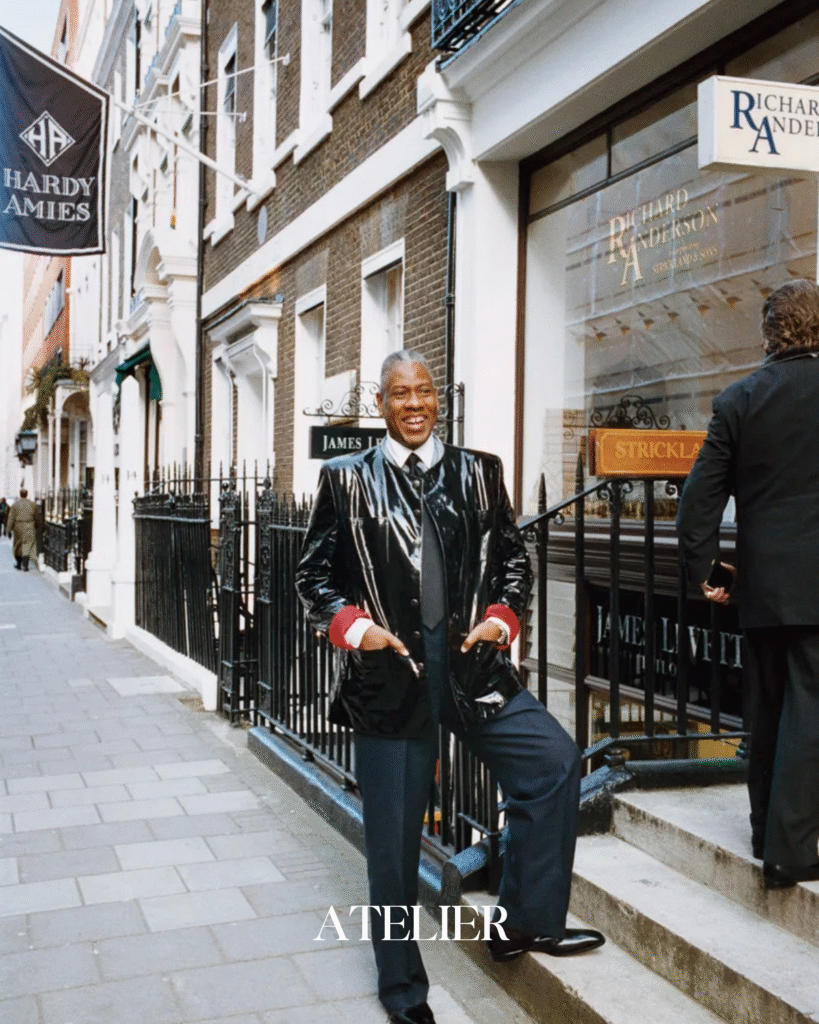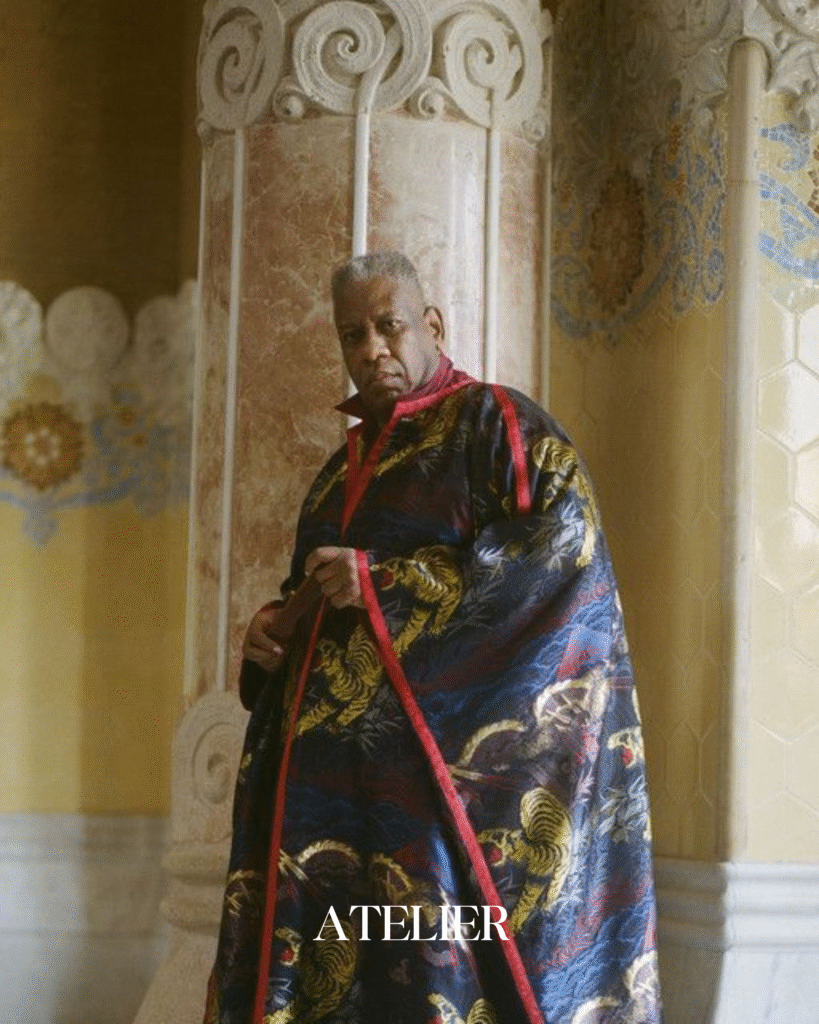
To understand André Leon Talley is to understand the evolution of fashion as both an industry and a cultural force. He was a guardian of its past, a champion of its potential, and a fierce critic of its failures. He was couture’s conscience—reminding it, often through sheer force of personality, that beauty must be inclusive, and that taste without intellect is hollow.
Talley was not merely a fashion editor. He was a curator of culture, a moral compass in an often superficial space, and a living archive of elegance. In a world that tried to box him in, he chose instead to live in bold, flowing silhouettes—both literally and metaphorically.
As fashion continues to reckon with representation, race, and legacy, André Leon Talley’s story remains both a cautionary tale and a shining blueprint. He proved that it is possible to love an industry deeply while holding it accountable—and that style, when wielded with conviction, can be a radical act of self-expression and cultural power.
Origins: Southern Roots and Early Impressions
André Leon Talley was born on October 16, 1948, in Washington, D.C., and raised in the deeply segregated town of Durham, North Carolina. His upbringing was marked by the nurturing presence of his grandmother, Bennie Frances Davis, a domestic worker at Duke University who raised him with dignity, faith, and discipline. In his memoir The Chiffon Trenches, Talley credited his grandmother as the cornerstone of his identity and his earliest understanding of elegance. Growing up Black and gay in the Jim Crow South, Talley often found solace in fashion magazines. His love affair with style began as a child, reading issues of Vogue at the local library and admiring the poised, seemingly untouchable worlds they depicted. These images, paired with the impeccable style of his grandmother and the community’s pride in Sunday fashion, instilled in him an innate sense of sartorial importance and narrative.

Education and Parisian Dreams
Talley earned his bachelor’s degree in French literature from North Carolina Central University in 1970 and went on to pursue a master’s degree at Brown University. There, he focused on French literature and immersed himself in European culture, aspiring to work in fashion or art. After Brown, he moved to New York City and quickly inserted himself into the center of the cultural universe.
His big break came with an unpaid apprenticeship with Diana Vreeland at the Metropolitan Museum of Art’s Costume Institute. The legendary former Vogue editor saw something rare in Talley—an understanding of fashion as culture and a scholar’s passion for detail. From that pivotal position, he moved on to write for Andy Warhol’s Interview, Women’s Wear Daily, The New York Times, and eventually Vogue.
Climbing the Ranks: The Man Behind the Curtain
During the late 1970s and into the 1980s, André Leon Talley cemented his place in the fashion world through his brilliance, charisma, and unmatched knowledge of style history. After years of working at publications like Interview and The New York Times, he became fashion editor for Women’s Wear Daily in Paris—a rare position for a Black man at the time. In Paris, Talley thrived. He moved fluidly between the ateliers of Yves Saint Laurent and the salons of Karl Lagerfeld, forming personal and professional relationships with designers who defined the era. His writing reflected not just trends, but the culture, art, and politics embedded in clothing, making him a sought-after voice in both fashion journalism and elite design circles.Talley’s deep understanding of the visual language of fashion, paired with his elegant but authoritative presence, made him indispensable. understood that fashion wasn’t frivolous; it was a form of power and storytelling. That ethos followed him when he joined Vogue in 1983, working under then-new Editor-in-Chief Anna Wintour. His voice and vision helped shape the magazine’s tone at a time when Vogue was redefining itself for a new generation. He became the ultimate behind-the-scenes force—crafting narratives, influencing covers, and serving as a gatekeeper for high fashion. Through his lens, fashion became elevated, dramatic, and socially resonant.

A Towering Figure in Fashion
Standing at 6-foot-6 and often cloaked in custom Tom Ford, sweeping capes, or regal caftans, André Leon Talley was an unmistakable figure in any room he entered. His style wasn’t just bold—it was intentional, rooted in cultural pride and a love of grandeur. “I love the spirit of excess. I love things that are over the top. And I love style,” he once said. But it was not just his physical presence or wardrobe that made him a giant in the fashion world—it was his encyclopedic knowledge, his booming baritone voice, and his ability to reference Balenciaga, Baudelaire, and Black history in the same breath. He made fashion criticism poetic, urgent, and deeply rooted in culture.
Talley brought a level of intellectual rigor and emotional resonance to editorial work that few could match. His writing was never just about clothes; it was about the people who wore them, the messages they sent, and the histories they carried. He viewed fashion as art, power, and identity all at once. That lens helped Vogue not only chronicle the latest trends but shape the global fashion conversation. With each feature and photoshoot, Talley layered in his understanding of glamour, race, and resistance, making the magazine smarter and more layered than it had ever been.
His relationships with iconic designers and cultural figures—Karl Lagerfeld, Oscar de la Renta, Marc Jacobs, Naomi Campbell, Edward Enninful, and countless others—were mutually influential. Talley was both muse and mirror to the fashion elite, shaping covers, orchestrating narrative arcs, and steering the visual and conceptual tone of American fashion media. More importantly, he used his influence to center Black beauty and talent at a time when it was often marginalized. “I fought for Black models,” he said. “I made it my mission to make them visible.” Long before inclusivity became an industry standard, Talley championed it with intention and tenacity
Challenges, Controversy, and Loneliness
Behind the scenes, Talley’s life was often shaped by struggle and heartbreak. While he occupied rarefied spaces with poise, his memoir The Chiffon Trenches revealed the personal costs of being both celebrated and isolated. “I was the only person of color in the upper echelons of fashion journalism, ” he wrote. “And I was always aware of that.” As a gay Black man in a world that was often neither inclusive nor kind, Talley battled loneliness. He rarely spoke publicly about his sexuality but admitted to never having a romantic partner, something that weighed heavily on him. “I have suffered loneliness. I have suffered isolation. I have felt dismissed and discounted,” he confessed in his book Talley’s relationship with Anna Wintour—once seen as one of fashion’s most enduring alliances—soured in his later years. While he had once been her confidant and collaborator, he ultimately felt discarded. “She is not capable of simple human kindness,” he wrote, a rare and painful admission from someone who had built so much of Vogue’s vision alongside her. The honesty of his memoir shocked the industry, pulling back the curtain on fashion’s coldness, its gatekeeping, and its penchant for using and discarding talent.
Yet for Talley, truth-telling was an act of liberation, a final reclaiming of his narrative. Beyond emotional wounds, Talley faced physical and financial challenges. He struggled with weight and body image throughout his life, an experience made more painful by the visual culture of the fashion world. In his final years, he became embroiled in a legal dispute over the ownership of the home he had lived in for years, a public and humiliating affair that underscored how even legends can be left vulnerable by the very systems they helped build. Still, through adversity, he never dimmed his brilliance or his belief in fashion’s power to affirm, uplift, and redefine.
Cultural Renaissance Man
André Leon Talley was far more than an editor—he was a cultural force, a true Renaissance man whose impact extended beyond the pages of Vogue. He served as a judge on America’s Next Top Model, bringing humor and high standards to mainstream audiences. He was a fixture on red carpets, offering commentary that was both entertaining and insightful. In 2018, his life became the subject of The Gospel
According to André, a critically acclaimed documentary that chronicled his rise from Durham to Paris to the front rows of global fashion. The film humanized the man behind the myth, revealing his wounds, wisdom, and unwavering faith in beauty. Talley also made his mark as an author and curator of history. His books—A.L.T.: A Memoir, A.L.T. 365+, and The Chiffon Trenches— served as both personal testimony and historical documentation. His tribute to Oscar de la Renta’s work was more than fashion adoration; it was a scholarly archive of design, creativity, and legacy. In his writing, Talley often situated fashion within the broader contexts of race, art, and power. He championed designers of color, highlighted overlooked historical figures, and wrote essays that read like love letters to Black cultural excellence.
Final Years and Lasting Legacy
André Leon Talley passed away on January 18, 2022, at the age of 73 due to a heart attack complicated by COVID-19. The news sent shockwaves through the fashion world and beyond. It felt like the final chapter of an era defined by boldness, intellect, and individuality. In the days that followed, designers, models, journalists, and celebrities shared personal stories of how Talley made them feel seen, heard, and elevated. His presence had not just opened doors; it had redefined the architecture of the room.
In 2023, the Savannah College of Art and Design honored his legacy with a sweeping retrospective exhibit. Titled ALT: The Life and Legacy of André Leon Talley, the show included his dramatic capes, handwritten notes, iconic magazine spreads, and never-before-seen video footage. More than a tribute, it was a reclamation—a public reminder of his magnitude. Meanwhile, discourse around his estate and final years sparked difficult but necessary conversations about how the fashion industry treats its elders, particularly Black creatives who helped build its foundations.

